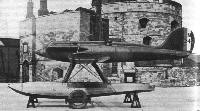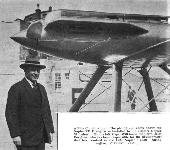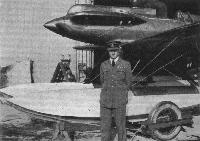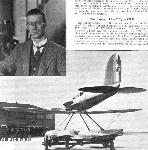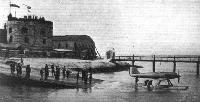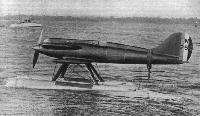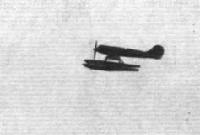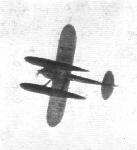
Варианты
- Gloster - I - III - 1923 - Великобритания
- Gloster - IV - 1926 - Великобритания
- Gloster - VI Golden Arrow - 1929 - Великобритания
Gloster VI
Проектирование гоночного гидросамолета Gloster V было прекращено, и лишь в начале 1928 года Генри Фолланд и его конструкторы приступили к разработке новой машины, отказавшись от схемы биплана в пользу моноплана. Самолет должен был участвовать в гонках на кубок Шнейдера 1929 года. Выполненный по схеме низкоплана, Gloster VI имел подкрепленное расчалками крыло и свободнонесущее оперение деревянной конструкции, а фюзеляж и поплавки были выполнены из легких сплавов. Почти вся поверхность крыла была занята радиаторами двигателя Lion VIID, а маслорадиаторы размещались по бортам фюзеляжа, за кабиной. Кроме того, дополнительные маслорадиаторы были установлены на верхней поверхности поплавков.
Построили два Gloster VI, но испытания в Кэлшуте в августе 1929 года показали, что форсированный Lion VIID быстро перегревается, и самолеты сняли с состязаний. Они закончили свои дни на базе ВВС в Феликстоу, причем все попытки решить проблемы с двигателем не дали результатов.
ТАКТИКО-ТЕХНИЧЕСКИЕ ХАРАКТЕРИСТИКИ
Gloster VI
Тип: одноместный гоночный самолет
Силовая установка: один W-образный поршневой двигатель Napier Lion VIID мощностью 1320 л. с. (984 кВт)
Летные характеристики: макс. скорость на высоте 30 м - 565 км/ч
Масса: пустого 1036 кг; максимальная взлетная 1669 кг
Размеры: размах крыла 7,92 м; длина 8,23 м; высота 3,29 м; площадь крыла 9,85 м!
Описание:
- Gloster VI
- Flight, August 1929
THE BRITISH SCHNEIDER TROPHY DEFENDERS
Фотографии
-
Aeroplane Monthly 1989-08 / K.Wixey - Folland's racers (3)
Регистрационный номер: N249 [12] This photograph of the Gloster VI N249 shows clearly how the wing section thickened towards the tips.
-
Flight 1930-04 / Flight
Регистрационный номер: N249 [12] THE GLOSTER-NAPIER VI: This three-quarter front view emphasises the beautiful lines of the machine.
-
Air Pictorial 1955-10 / The journal of a roving spotter
Регистрационный номер: N249 [12] GLOSTER VI GOLDEN ARROW. Two specially built Gloster VI single-seat racers were entered for the 1929 Schneider Trophy Contest - N249 and N250. Misfortune in the form of technical snags (petrol feed and air intake faults) could not be solved in time to prevent the entries from being withdrawn. However, N249 had a short-lived triumph when flown by F/Lt. G. H. Stainforth of the R.A.F. High Speed Flight on 10th September 1929. Over Calshot, N249 broke the Absolute Speed Record, averaging 336.3 m.p.h. Two days later, S/Ldr. A. H. Orlebar of the same Flight flying a Supermarine S.6, averaged 357.75 m.p.h. over a 3-km. course and gained the F.A.I.-recognised World Speed Record.
Designed by the late H. P. Folland, at that time Chief Designer of the Gloster Aircraft Company, the Gloster VI was the first of the Gloster monoplane breed. The clean lines of this spruce sheet-covered seaplane were enhanced by the low frontal area Napier Lion VIID racing Vee 12-cylinder engine, designed by Capt. A. S. Wilkinson. Painted high-gloss gilt overall, the Gloster VI lived up to its name Golden Arrow, if only briefly. -
Aeroplane Monthly 1989-08 / K.Wixey - Folland's racers (3)
Регистрационный номер: N249 [12] The Gloster VI N249 Golden Arrow fitted with a Napier Lion VIID engine of 1,320 h.p. On September 10, 1929, N249 attained an average speed of 336 3 m.p.h. during four runs over the previous day's Schneider course.
-
Flight 1929-08 / Flight
Регистрационный номер: N249 [12] -
Flight 1929-08 / Flight
Регистрационный номер: N249 [12] Daintiness personified: This side view of the Gloster-Napier VI gives, by the "scale" supplied by the R.A.F. personnel standing around, a good idea of the smallness of the machine.
-
Flight 1929-08 / Flight
Регистрационный номер: N249 [12] A Fine Combination: The photograph shows the Napier VII D engine as installed in the Gloster-Napier VI. On the left, Capt. Wilkinson, Napier's Chief Designer, who has been responsible for the development that has resulted in the 1929 Napier "Lion" racing engine.
-
Flight 1929-09 / Flight
Регистрационный номер: N249 [12] Flight-Lieutenant Stainforth in front of the Gloster-Napier VI on which he established a world's speed record of 336-3 m.p.h.
-
Aviation Historian 9 / R.Pegram - Folland's Forgotten Monoplanes (1)
The exceptionally aerodynamically clean Gloster VI, Folland’s first monoplane design. A contemporary newspaper remarked that “it seems more the conception of an artist who can create with the stroke of a brush than the work of a designer who is bound by engineering principles and the inelasticity of timber and metal”.
-
Flight 1929-08 / Flight
THE GLOSTER-NAPIER VI: The extremely small cross-sectional area is well brought out in these front and rear views.
-
Flight 1929-08 / Flight
Регистрационный номер: N249 [12] THE MAN AND THE MACHINE: Above, Mr. H. P. Folland, Chief Engineer and Designer of the Gloster Aircraft Co., and the very pretty monoplane produced for this year's Schneider Trophy Contest.
-
Aeroplane Monthly 1974-09 / ??? - Hendon Pageantry 1920-37
Регистрационный номер: N250 [2] The two British Schneider types. Nearest is the Gloster-Napier VI, and behind that the Supermarine Rolls-Royce S.6, which won the contest and established a world's speed record of 357 m. p. h.
The Gloster Napier VI, nearer the camera, and the Supermarine S.6 also appeared at the 1930 pageant.Другие самолёты на фотографии: Supermarine S.5 / S.6 - Великобритания - 1927
-
Flight 1929-08 / Flight
Регистрационный номер: N249 [12] King of the Castle? The Gloster 6 racing monoplane (Napier racing engine), standing easy within the shadow of Calshot Castle. Its secret performance creates a fascinating speculation.
-
Мировая Авиация 140
Регистрационный номер: N249 [12] Самолет N249, первый Gloster VI, был сфотографирован в Кэлшуте незадолго до установления абсолютного рекорда скорости - 10 сентября 1929 года он разогнался до 541,21 км/ч.
-
Flight 1930-06 / Flight
Регистрационный номер: N250 [2] THE GLOSTER-NAPIER VI: Designed for last year's Schneider Trophy Contest. Is now being re-conditioned and will be flown a good deal in the near future. Napier Racing engine.
-
Flight 1929-09 / Flight
AFLOAT AND A-WING AT CALSHOT. THE GLOSTER VI ON ITS FIRST TEST FLIGHT
-
Flight 1931-09 / Flight
TRAINING: One of the Gloster-Napier VI monoplanes, which have been used extensively for practice flying by the Schneider Team.
-
Flight 1929-08 / Flight
The Napier "Lion" VII D: Of even smaller overall size than the 1927 model, this year's Napier racing engine is supercharged, and gives considerably more power than previous types.
-
Flight 1930-10 / Flight
SCALE MODELS: Four realistic scale models made by Mr. D. M. Dent from cardboard and other "oddments." One of they is - Gloster-Napier VI
-
Aviation Historian 11 / R.Pegram - Folland's Forgotten Monoplanes (3)
“What Folland did years ago, people are doing today” - this 1939 advertisement for Folland Aircraft Ltd, formed after Folland left Gloster in 1937, capitalises on the perception of Folland as the designer of highly advanced aircraft by using his Gloster VI floatplane, built for the 1929 Schneider Trophy.
-
Air Pictorial 1955-10 / The journal of a roving spotter
GLOSTER VI GOLDEN ARROW. Data: Span 26 ft.; loaded weight about 3,700 lb.; max. speed 351.6 m.p.h. at sea-level. No other data available.
- Фотографии




